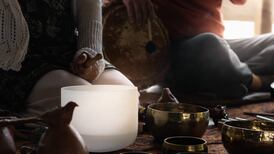As military arsenals go, a fleet of tractors, a flock of several hundred sheep and a collie named Stalin might not shake the Kremlin. However, a group of French farmers were relying on good old democratic values when they took on the Paris police force on the Champ de Mars.
Thrown by the wily behaviour of the animals, the police had to come and ask the protesters for help. The press also took a more romantic view of the direct action, not realising, as one of the protestors put it, “how horrible and bad tempered the animals can be”.
This was over 45 years ago, but farmer Michel Courtin could have been describing more recent struggles as he recounted with some humour his experiences for a recent award-winning documentary directed by Christian Rouaud. Entitled Tous au Larzac, the film draws on television news archives, interspersed with contemporary interviews , to recall the 10-year battle by a tiny community against French government plans to acquire their land for extension of a military base.
We didn't have any weapons, we never brandished a gun, our most dangerous weapon was a pot of paint', used for graffiti
Courtin and neighbours in the area best known for Roquefort cheese recall how they had been typically conservative and non-political, and appalled by news footage of student protests in May 1968 – only to have their own “1968 moment”, complete with support from young urban activists, several years later. French secretary of state André Fanton had dismissed them as a “few peasants, who desultorily raise a few sheep, while living the life of the Middle Ages” when justifying the government’s plans for the land acquisition in the early 1970s.
“We didn’t have any weapons, we never brandished a gun, our most dangerous weapon was a pot of paint”, used for graffiti, Courtin and neighbours recall.
In spite of attempts to buy them up, blow them out – one farmhouse exploded in unexplained circumstances – and infiltrate their peaceful movement, the community of 103 families held together and won their struggle.
Disillusioned with later press coverage which portrayed them as anarchists, they founded their own newspaper which still survives, and they are part of an anti-globalisation movement involving José Bové, the farmer imprisoned for three months for vandalising a McDonald’s fast food restaurant and who is known as the “Asterix of Larzac”.
Last week’s screening of the film in the Galway-Mayo Institute of Technology (GMIT) was hosted by French honorary consul Catherine Gagneux to mark a “night of ideas” – a culture night for Francophiles, held simultaneously across several continents and a great taster for the separately excellent Subtitle European film festival.
In a discussion afterwards which ranged from Simone de Beauvoir to decolonisation, NUI Galway head of French Prof Phil Dine and GMIT French professor Sarah Berthaud gave their interpretations of the theme “all power to the imagination”, as in the 1968 Paris protest slogan which underpinned the creative energy in Larzac.
People say we must be out of our minds . . . but if you were fully sane, you'd do nothing at all
Danny Sheehy or Domhnall Mac an tSíthigh would have been very at home in the Larzac community in another life.
His own contact with the soil was in Kerry, where he also fished, taught, and wrote award-winning poetry and prose.
His sudden death last year after his naomhóg capsized off the Iberian coast has left his family and many friends bereft.
“People say we must be out of our minds . . . but if you were fully sane, you’d do nothing at all”, Sheehy had said before setting out on the three-season “camino by sea” from Ireland to northern Spain to prove it could have been done by skin-boat centuries before. Several years previously, he had also sailed with skipper Paddy Barry from Kerry to Iceland, tracing a route said to have been taken by St Brendan and fellow monks.
His Irish-language account of that 2011 Iceland voyage was published in hardback by An Sagart, run by the late Msgr Pádraig Fiannachta. The same publisher has now released an English translation by Camilla Dinkel, entitled In the Wake of St Brendan: From Dingle to Iceland.
Sheehy’s blood brother, musician Breanndán Ó Beaglaoich, believes Dinkel captured the essence of her subject – such as in her English translation of his reaction to finding a Scottish hotel bar shut, and he with his throat “parched as that of a crested lark” and his tongue “as long and dry as an iron thole pin”.
Sheehy’s spirit will be with Ó Beaglaoich this Friday when he opens the annual Éigse na Brídeoige festival to mark St Brigid’s Day in Kerry’s Uíbh Ráthach, encompassing Ballinskelligs, Caherdaniel and Waterville.
Maritime historian and folklorist Críostóir Mac Cárthaigh,marine biologist Eleanor Turner and Valentia Coast Guard divisional controller John Draper are among scheduled speakers over this February 3rd/4th weekend on the theme of Éigse na Farraige/Tides and Tales, and music will include a concert by Dordán.
For more information, contact 066 9474888 or check the eigsenabrideoige.com website.














